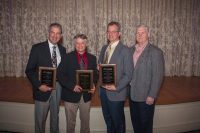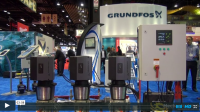https://www.youtube.com/watch?v=8-oEEpWgeNY Read more
Heating & Cooling

Five employees from the Applied Water Systems (AWS) business unit of Xylem were recently recognized by the Hydraulic Institute (HI) for their longtime service to and involvement in HI, the largest association of pump industry manufacturers in North America. The recognition took place during the organization’s 2015 annual meeting in St. Petersburg, Florida. “Xylem Read more
Five employees from the Applied Water Systems (AWS) business unit of Xylem were recently recognized by the Hydraulic Institute (HI) for their longtime service to and involvement in HI, the largest association of pump industry manufacturers in North America. The recognition took place during the organization’s 2015 annual meeting in St. Petersburg, Florida.
“Xylem has one of the greatest, if not the greatest, number of participants helping to shape the future of the pump and hydronic systems industry, including significant involvement in defining efficiency standards and government regulations,” said Dave Flinton, Vice President, Engineering and Marketing, AWS. “These awards highlight Xylem’s leadership in the industry, and the deep expertise our people have.”
Awards and the team members they were presented to are as follows:
- Mark Handzel, Vice President Product Regulatory Affairs and Director, HVAC Commercial Buildings, Americas – Industry leadership Award for U.S. Department of Energy pump efficiency regulations
- Mark Heiser, Test & Validation Manager – Industry Leadership Award for development of HI Standard 40.7 and recognition for completion of standard development for DOE pump efficiency regulations
- Paul Ruzicka, Chief Mechanical Engineer – Industry Leadership Award for development of HI Standard 40.6 and recognition for completion of standard development for DOE pump efficiency regulations
- Chris Johnson, Global Engineering Manager, Centrifugal Pumps – Recognition for contributions to HI standards development
- Jim Roberts, Associate Principal Mechanical Engineer – Recognition for 20 years of service to the development of HI standards

Last year, OESP announced setting up a scholarship/grant in Dan Holohan’s name and he is helping raise money for this purpose. Well, why not actually auction Dan off himself? According to Holohan, “This is my final year of doing seminars. My last will be at the AHR show in Orlando next January. I will be Read more
 Last year, OESP announced setting up a scholarship/grant in Dan Holohan’s name and he is helping raise money for this purpose. Well, why not actually auction Dan off himself?
Last year, OESP announced setting up a scholarship/grant in Dan Holohan’s name and he is helping raise money for this purpose. Well, why not actually auction Dan off himself?
According to Holohan, “This is my final year of doing seminars. My last will be at the AHR show in Orlando next January. I will be 66 years old on that day, and it will be time to shut up. But before I’m done, I’d be happy to do a private (or public) seminar for you and a group of any size and of your choosing. I have also spoken several times to groups of one, so if you’d rather have a one-on-one with me for three hours, I’m up for that as well. Why am I doing this? Well, it’s because OESP had the fine idea of naming a grant after me, which will benefit those who teach in the HVAC field. The winners of the grant may use the money for their own continuing education, or to enhance their classrooms with purchased equipment. And since my name is on the grant, I feel like raising some money for it before I shut up for good. So bid on me like crazy. One-hundred percent of what you bid will go to the teachers. If you win, you and I will look at the calendar and pick a date for me to do any one of these three-hour seminars – The World of Green Heating, Classic Hydronics or, Dead Men’s Steam School. You’ll arrange the meeting place at your expense. I’ll pay my own travel expenses (within the United States). I can also help you publicize the event through the power of HeatingHelp.com if you’d like. So take me; I’m yours!”
The winner of this auction will be announced at the convention of the National Association of Oil & Energy Service Professionals – May 19th Awards Banquet, Hershey, PA.
If interested, http://www.ebay.com/itm/Dan-Holohan-is-All-Yours-/261840070801
The Dan Holohan Grant:
Send completed application to:
National Association of Oil & Energy Service Professionals
Attn: Judy Garber, Exec. Director or e-mail jgarber@thinkoesp.org
Eligibility:
- Any HVACR instructor is eligible for grant money.
- Can be used for classroom materials or equipment, specialized training that is not paid or reimbursed by the school and we are open to other requests that may arise.
Details and Instructions:
- Complete the basic application below and include a couple of paragraphs that tell us in detail why you need the money and how you and the HVACR industry can benefit by our investment.
- Include a reference along with their contact information
- Submit this form no later than July 1, 2015
- 2015 is the 1st year of this grant, thus we reserve the right to control the number of grants awarded and for how much.
- Any questions, call 1-888-552-0900
PLEASE PRINT OR TYPE
Name: _______________________________________________________________
Last First Middle
Currently teaching: _______________ (Yes or No)
Name of the School ____________________________________
Address: ______________________________________________________________
City/Town: __________________________ State: _______ Zip: ______________
Telephone Number: ________________________
E-mail Address: _____________________________________________

https://youtu.be/z8Yn7YcfbUk While real estate sales have improved across the country, growth has chiefly been seen in the mid-range market. Homes in the 1,200 to 2,500-square-foot range are spending less time with a realtor’s sign in the front yard. But new home construction has lagged, especially in the custom home business. Few people know this Read more
https://youtu.be/z8Yn7YcfbUk
While real estate sales have improved across the country, growth has chiefly been seen in the mid-range market. Homes in the 1,200 to 2,500-square-foot range are spending less time with a realtor’s sign in the front yard.
But new home construction has lagged, especially in the custom home business. Few people know this better than trade pros who provide the more luxurious options. In New Jersey, Jim Hedden is among those feeling the crunch.
“Most of our new construction business is in homes between 9,000 and 13,000 square feet, with a few towards 25,000,” said Hedden, who own George’s Plumbing and Heating Inc. His father started the company in Clinton, New Jersey in 1959. “That market slid hard in 2008 and hasn’t picked up recently, even though things are improving with the construction of average homes.”
But the company is still healthy, due in part to their widely varying residential retrofit work. Hedden also attributes their success to changes he’s made to become more competitive when those rare high-end jobs arise. “Any way I can shave expenses without sacrificing quality is a must,” said Hedden.
Controls add value
“Price point is definitely an important part of making a sale, but the other part of it — especially with the big homes — is what I can offer that other guys may not,” said Hedden. “Zone responsiveness and efficiency don’t often go hand in hand with a low installation price. There is firing efficiency, system efficiency and seasonal efficiency, to mention a few of the ‘efficiencies’. The price of installation and the effect it has on the price of maintenance need always be considered.”

Hedden has found that using indoor temperature feedback, as well as outdoor reset, is the ultimate combination for comfort and efficiency.
About two decades ago when radiant heat was re-emerging in the U.S., and long before broad use of condensing boilers was being discussed here, Hedden was among the many installers trying to find the best way to keep return temperatures above 140°F, thus eliminating the possibility of condensation within the traditional non-condensing boilers.
At the time, he used a tekmar-controlled variable speed injection pump (working like an automotive transmission) to both temper supply water going to the in-floor loops and change the water temperature in correlation to the outdoor air temperature (outdoor reset). Using a boiler’s thermistor to retain minimum water temperature, it made both high- and low-mass radiant systems work seamlessly with non-condensing boilers.
Hedden followed the evolution of the tekmar control system and is still using it today. In this post-mod-con, outdoor reset, indoor feedback world, he’s found almost limitless use for the controls – especially in the hi-end residential market he prefers to work in.
“Today’s ability to modulate a boiler down to supply a specific temperature changes the rules, as does variable speed injection pumping, but we still do some jobs that use proportional mixing valves for in-floor zones,” said Hedden. “But it’s not just about radiant anymore. We’ll use tekmar for virtually everything; commercial and residential.”
“Many control systems cater to — and do a great job — on specific space heating or DHW demands, but do not address the entire hydronic system,” said Hedden. “While managing multiple boilers [lead-lag and rotate], changing the boiler water temperature differential and synchronizing space heating zone ‘calls’ to reduce boiler firing cycles, as well as including outdoor air temperature reset tempered by indoor air temperature feedback — parallel shift of the reset curve — tekmar provides for a complete DHW and heating and cooling system package.”
“It can even vary the amount of priority time that DHW has over space heating zones depending on the outdoor ambient temperature,” Hedden continued. “If it’s especially cold outside, the DHW system might get only 10 minutes of priority.”
Still busy
“If keeping the trucks out on the job is the goal, there’s no substitute for being able to complete a variety of work,” continued Hedden. “Do it competitively, with good pricing and offerings that the next guy doesn’t have, and you’ll stay busy.”
One strange job that George’s P+H completed recently included a 450-sq.-ft. addition with radiant in-slab heating. Oddly, the boiler was a steam unit. Instead of telling the homeowner that he couldn’t keep his steam boiler and have in-floor heat — as three other mechanical professionals did — Hedden improved on an old trick he’d learned years before.
“We drilled and tapped the existing steam boiler below the water line, and pumped the hot water through a coil on a 40-gallon indirect tank,” explained Hedden. “A second circulator moved pressurized from the tank, through the floor.”
To assure that floor temperatures were optimal, he used a tekmar temperature differential controller with an outdoor sensor, and a sensor in the tank. The outdoor sensor acted as a reset. The two pumps act independently to provide the correct supply temperature and flow rate for the floor.
“We get creative when we need to, but we’ll stay busy regardless of the market,” said Hedden. So far, he’s right on both accounts.

The world of separation, relating to hydronics continues to evolve and expand. Most hydronic and HVAC contractors understand the importance of air and dirt separation. They understand the need to keep high performance equipment operating at peak efficiencies. A big part of that is keeping the piping and components air and dirt free. It is Read more
The world of separation, relating to hydronics continues to evolve and expand.
Most hydronic and HVAC contractors understand the importance of air and dirt separation. They understand the need to keep high performance equipment operating at peak efficiencies. A big part of that is keeping the piping and components air and dirt free.
It is well documented the importance and value of scrubbing the systems free of all dissolved and entrained air. The goal is to provide the very best heat transfer from the wall of the heat exchanger to the fluid. This is true for all fluid based systems hot or chilled.
The micro-bubble type of air removal devices have revolutionized the way we efficiently remove the smallest of air molecules. The micro-bubble removal devices are the industry standard now. They are well worth the additional cost when compared to a basic scoop type air removal device.
For dirt and particle removal, strainers have been the go-to product for decades. There are some limitations to a strainer or filter type of device. The most common Y pattern strainers present some flow resistance, even when brand spanking new. As they remove particles from the fluid stream flow is further diminished until they are cleaned and serviced.
 The same concept applies to dirt as air. Separate the particles, trap them in a lower chamber away from the fluid stream where they will not obstruct or limit flow. A simple ball valve at the bottom allows them to be blown down or flushed out. Use a small bucket when you first blow them down to see what lurks inside your systems. You may be surprised as to what you find. Commonly pipe joint tape, solder balls, copper or steel chips or burrs that were removed are will flush out. A motorized valve could be added to program a flush for and on-going basis. This would apply to particularly dirt and rust prone systems. Cast iron radiators or steel pipe would be a good example of a prime candidate for dirt separation.
The same concept applies to dirt as air. Separate the particles, trap them in a lower chamber away from the fluid stream where they will not obstruct or limit flow. A simple ball valve at the bottom allows them to be blown down or flushed out. Use a small bucket when you first blow them down to see what lurks inside your systems. You may be surprised as to what you find. Commonly pipe joint tape, solder balls, copper or steel chips or burrs that were removed are will flush out. A motorized valve could be added to program a flush for and on-going basis. This would apply to particularly dirt and rust prone systems. Cast iron radiators or steel pipe would be a good example of a prime candidate for dirt separation.
Lately we are seeing another option to dirt separation products called magnetic separation. By adding a magnetic component to the separator we can pull out the finest of particles. One common concern is older non–barrier tube hydronic systems. Plastic, PB EPDM and PEX have been used as hydronic and radiant tube.
Oxygen molecules can enter thru the wall of the tube, that does not include a 100% O2 barrier, and support corrosion. The fine magnetic sludge you will encounter is called magnetite. It’s basically made up of the corrosion byproducts of the ferrous components in a system. Cast iron body pumps and steel expansion vessels are just a couple examples of ferrous components.
Keep in mind the barrier added to some of the plastic tubing products does not stop O2 ingress 100%. Higher operating temperature systems tend to draw more O2 into the system.
One way to remove these fine particles, which are too fine to trap with a common mesh type filter, is a powerful magnet. By installing a powerful magnet or series of magnets we can attract and trap any ferrous metal particles. The magnets are either installed as a band around the outside of the separator, inside the device, or into a well in the separator.
Some brands of separators include the media to remove particles down to a 5-micron size, and use a magnet option for the finer magnetite removal.
Know magnetite by the fine, almost talcum powder consistency. It sometimes has an oily or greasy feel and will coat your fingers almost like a thick metallic paste. It reminds me of those anti-seize compounds used for engine assembly.
 Another new and exciting change in our industry is the availability of ECM motor technology for circulator pumps. This type of motor has a very strong permanent magnet inside. Under some circumstances the magnetite call travel through the bushings and seals and get trapped against the rotor of the motor. Rhyme intended.
Another new and exciting change in our industry is the availability of ECM motor technology for circulator pumps. This type of motor has a very strong permanent magnet inside. Under some circumstances the magnetite call travel through the bushings and seals and get trapped against the rotor of the motor. Rhyme intended.
If enough gets trapped in the small space between the rotors and can it can impede or lock the motor from spinning.
Pump manufacturers have built in protection to alleviate and minimize the potential. Samples and pictures from the field, sent to our office monthly indicate there may still a need to add magnetic separation to assure the best possible removal of the fine magnetic particles flowing thru our systems. Expect to see more and more versions and sizes of magnetic separators. Also note some products on the market offer 4 functions : air, dirt, hydraulic, and magnetic separation in one device.
Sleep well at night knowing you have taken the best steps to protect your customer’s investment. That’s my story and I’m sticking to it.
 Bob ‘Hot Rod’ Rohr is currently the training and education manager for Caleffi North America. He owned his own contracting company, Show Me Radiant Heat & Solar, Rogersville, Mo. He has been a plumbing and heating contractor since 1978.
Bob ‘Hot Rod’ Rohr is currently the training and education manager for Caleffi North America. He owned his own contracting company, Show Me Radiant Heat & Solar, Rogersville, Mo. He has been a plumbing and heating contractor since 1978.






